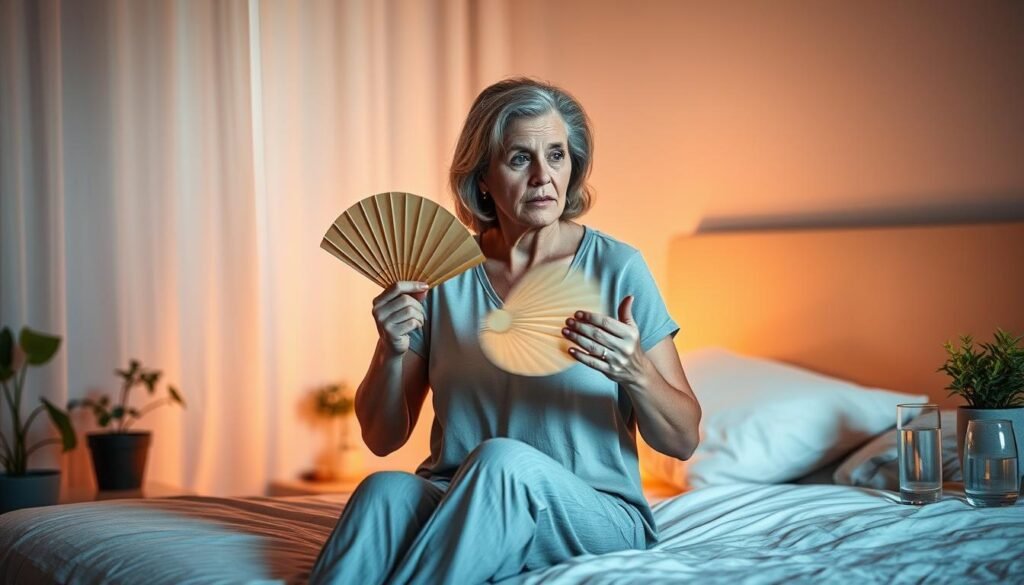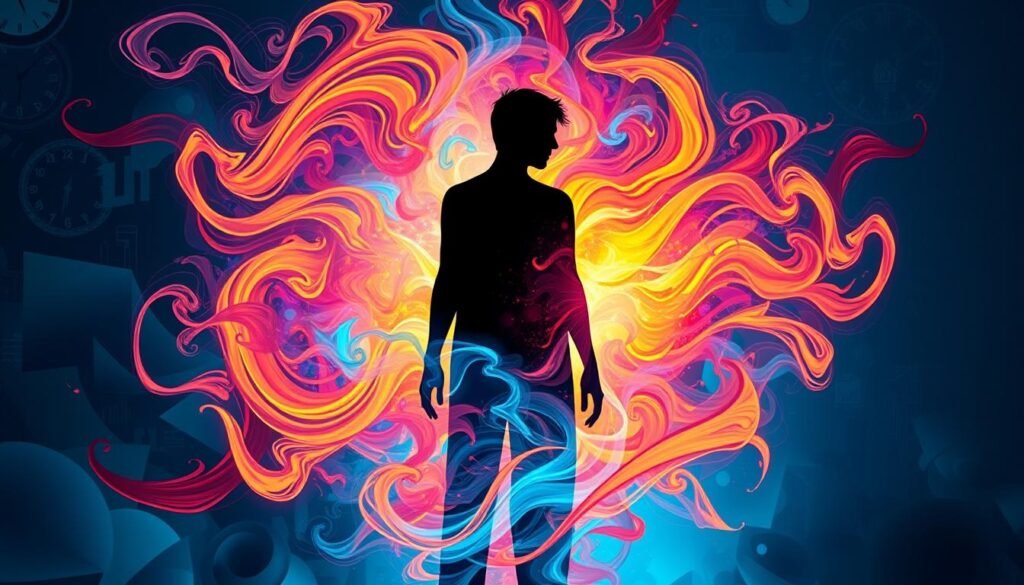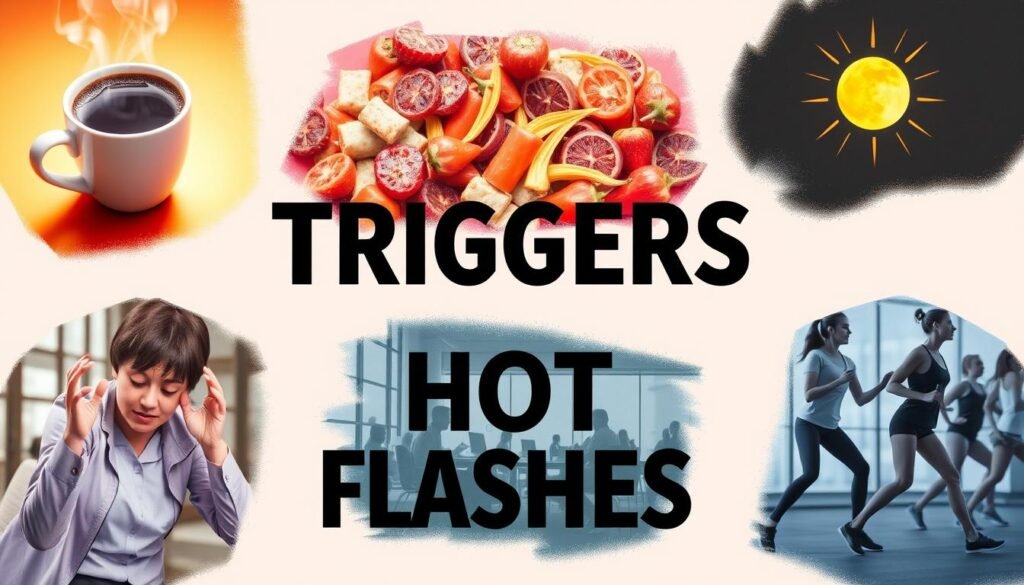Did you know over half of women aged 40-58 experience hot flashes in perimenopause? This statistic shows how significant anxiety hot flashes are in women’s lives. These episodes of warmth can come from hormonal changes during menopause. But, anxiety and stress can also trigger them. Since menopause symptoms like hot flashes often last for seven years, linking anxiety with these episodes is key for handling them well.
The link between anxiety and hot flashes is not simple. It’s known that hormone imbalances cause menopause symptoms. Yet, stress and anxiety can make these feelings worse. This piece dives into the causes of anxiety hot flashes and how to alleviate them. People can take steps to feel better and take charge of their health. For more information, Medical News Today offers deep insights.
Key Takeaways
- Hot flashes are common, affecting over half of women during menopause.
- Anxiety can significantly compound the severity and frequency of hot flashes.
- Exploring natural remedies and lifestyle changes can provide effective relief.
- Hot flashes may arise in men due to various health conditions.
- It is important to consult a healthcare provider if hot flashes disrupt daily life.
Understanding Hot Flashes
Hot flashes are common during times like menopause. They are sudden feelings of heat. It’s important to know how often they happen and what they feel like.
What Are Hot Flashes?
Hot flashes come suddenly, feeling like a wave of heat. They bring intense warmth, mainly to the face, neck, and chest. Along with heat, people may sweat, turn red, or feel cold. Some also notice their heart beats faster by 7 to 15 times a minute.
These episodes last from one to five minutes. They can really impact someone’s life, especially women in menopause.
How Do They Feel?
Hot flashes can make you feel like you’re in a sauna. This can make you anxious or irritable. They can last more than seven years for some, impacting daily life.
Many women have them daily during menopause. They could lead to more serious health problems, like heart disease and bone loss. Unhealthy habits increase these risks.
| Aspect | Details |
|---|---|
| Duration | Hot flashes persist on average for over 7 years. |
| Frequency | Most women report daily occurrences. |
| Race | Least frequency observed among Asian women. |
| Health Risks | Increased risk of heart disease and bone loss for those experiencing hot flashes. |
| Anxiety Link | Women with anxiety are 3-5 times more likely to experience hot flashes. |
| Insomnia | 40-50% of individuals report sleep disturbances during menopause. |
When Do Hot Flashes Occur?
Hot flashes can happen to different people at various times. They are common and often linked to hormonal changes. For women, they mainly occur during perimenopause and menopause.
Age and Life Stages
Hot flashes usually start in the perimenopause stage, around the age of 40. As ovarian function slows and estrogen levels drop, symptoms like night sweats and irregular periods appear. During menopause, up to 80% of women experience hot flashes. They can last from 30 seconds to 10 minutes.
On average, hot flashes may continue for 7 to 10 years. Women who undergo surgical menopause report more severe hot flashes.
Men vs. Women
Hot flashes aren’t only for women; men have them too but not as often. They can happen because of hormonal changes, some medications, and health issues. Having lower levels of estradiol or progesterone increases the risk.
Lifestyle choices like smoking, being overweight, and stress can make hot flashes worse. They can make them more intense and longer.

| Gender | Age-Related Factors | Likelihood of Hot Flashes |
|---|---|---|
| Women | 40+ years; Perimenopause and Menopause | 80% experience hot flashes |
| Men | All ages; Hormonal changes | Occasional episodes due to health conditions |
Causes of Anxiety Hot Flashes
Knowing why anxiety hot flashes happen can make us more aware of them. Two main factors play a big role: hormonal changes and stress. These factors work together, making a cycle that’s hard to escape.
Hormonal Changes and Imbalances
Menopause causes your estrogen levels to go up and down. This affects how your body controls temperature. Suddenly, you might feel very warm and start sweating. It’s common, with over 80% of women facing it during menopause. These hormone shifts can bother you for 7 to 14 years, causing a lot of discomfort.
Anxiety and Stress Contributions
Anxiety doesn’t just make you feel warmer. It can also cause hot flashes when you’re stressed. In the US, about 31% of people will deal with an anxiety disorder at some point. Women are more likely to get these disorders. Women who worry a lot are almost five times more likely to get hot flashes than women who don’t.
Here’s how anxiety and hot flashes feed each other: More anxiety means more hot flashes. This can make you feel even more stressed. If your anxiety spikes, your blood vessels narrow, and your temperature can shoot up. This makes the hot flashes worse. But, deep breathing can help break this cycle and make the hot flashes less severe.

| Factor | Impact on Hot Flashes |
|---|---|
| Hormonal Changes | Fluctuating estrogen levels disrupt body temperature regulation, increasing hot flash occurrences. |
| Anxiety | Heightened anxiety raises body temperature and triggers stress-related hot flashes. |
| Stress | Intensity of stress can create a feedback loop, leading to more frequent hot flashes. |
| Vasoconstriction | Occurs during anxiety, causing temperature spikes that may result in hot flashes. |
Common Symptoms Associated with Hot Flashes
It’s important to know the symptoms of anxiety hot flashes for good management. These symptoms can show through physical and emotional ways. They create a cycle that impacts someone’s overall happiness.
Physical Reactions
People often face many physical reactions during anxiety hot flashes. Common symptoms include:
- Flushing and sweating
- Chills
- Increased heart rate
These symptoms are similar to menopause-related hot flashes, which can cause confusion. The sudden heat, sweat, and fast heartbeat can make people uneasy. This is true in social settings or during daily tasks.
Emotional Responses
Hot flashes can also lead to strong emotional reactions. People might feel:
- Anxiety
- Irritability
- Difficulty concentrating
This emotional stress can get worse during panic attacks with rapid breathing and a sense of doom. To handle anxiety better, stress management techniques like deep breathing and being mindful are helpful.
Triggers for Hot Flashes
Knowing what triggers hot flashes is key in managing these uncomfortable moments. Finding out specific environmental factors and lifestyle changes can help. This is especially true for women going through menopause.
Environmental Factors
Some environmental factors can really bring on hot flashes. Things that can make symptoms worse include:
- Heat: Warm environments might trigger hot flashes, making you feel more uncomfortable.
- Humidity: High humidity can make you feel hotter and heavier.
- Fabrics: Tight or synthetic clothes can trap heat, making hot flashes more intense.
Lifestyle Contributors
Certain lifestyle changes can also increase how often you get hot flashes. These factors are commonly linked with these symptoms:
- Alcohol Consumption: Drinking alcohol might make hot flashes worse for some people.
- Spicy Foods: They can raise your body’s temperature and trigger symptoms.
- Tight Clothing: Clothes that are too tight can limit airflow and make your body hotter.
- Smoking: Using tobacco is connected to more severe hot flashes.
- Caffeine Intake: Too much caffeine can stimulate your body, possibly making symptoms worse.

Managing Anxiety Hot Flashes
To handle anxiety hot flashes well, start by understanding what sets them off for you. Knowing your triggers is key to finding ways to deal with them.
Recognizing Personal Triggers
Pointing out what sparks your hot flashes can really help. Things like caffeine, alcohol, stress, and hormone changes are common causes.
- Caffeine consumption
- Alcohol intake
- Emotional stressors
- Hormonal fluctuations
Track these triggers to cut down on hot flashes. Avoiding these things can make a big difference in how often you get them.
Keeping a Diary for Tracking
It helps to keep a diary of your hot flashes. Write down when they happen and what you think caused them. Include:
- Recording the time and duration of hot flashes
- Noting emotional states before and after episodes
- Logging dietary habits, physical activity, and sleep quality
This careful tracking helps tailor your approach to managing hot flashes. For instance, if certain foods trigger them, you can adjust your diet accordingly. Understanding these patterns is crucial for better control.
| Symptom | Potential Trigger Factors | Management Strategies |
|---|---|---|
| Hot Flashes | Caffeine, Stress, Hormones | Avoidance, Deep Breathing |
| Anxiety | Stress, Lack of Sleep | Mindfulness, Relaxation Techniques |
| Sweating | Spicy Foods, Alcohol | Dietary Adjustments |
By using these methods, you can understand your hot flashes better. This leads to more effective control and improves your life overall.
Natural Relief Tips for Hot Flashes
Individuals experiencing hot flashes often seek effective natural remedies to ease their discomfort. Certain lifestyle changes, dietary adjustments, and mind-body techniques can help. These steps can provide relief and improve overall quality of life.
Lifestyle Changes
Adopting certain lifestyle changes can greatly reduce the frequency and intensity of hot flashes. Here are some useful tips:
- Wearing breathable, layered clothing to help regulate body temperature
- Avoiding known triggers such as spicy foods, caffeine, and alcohol
- Maintaining a cool environment, which can alleviate symptoms during a hot flash
- Regular exercise to help manage weight and reduce stress levels
Dietary Adjustments
Making dietary adjustments can also provide natural relief. Eating foods rich in phytoestrogens is one key strategy. Some good choices include:
- Soy products, like tofu and edamame, which may lower hot flash frequency
- Flaxseeds, known for their ability to alleviate vasomotor symptoms
- Leafy greens, essential for nutrients and hormone balance
Mind-Body Techniques
Adding mind-body techniques to your daily routine can help you cope better. These methods include:
- Yoga, which promotes relaxation and can alleviate tension
- Mindfulness meditation, to center thoughts and reduce stress
- Deep breathing exercises that encourage a calm response during hot flashes
Complementary Approaches
While research on some natural remedies is ongoing, many find these methods helpful for hot flashes. A multifaceted approach can lead to symptom relief and a better sense of well-being.
| Natural Remedies | Examples | Benefits |
|---|---|---|
| Lifestyle Changes | Layered clothing, exercise | Reduce frequency and intensity of hot flashes |
| Dietary Adjustments | Soy, flaxseeds, leafy greens | Support hormonal balance and reduce symptoms |
| Mind-Body Techniques | Yoga, meditation, breathing exercises | Enhance relaxation and reduce anxiety |
Therapies for Anxiety and Hot Flashes
Dealing with anxiety and hot flashes can be tough. Yet, there are good therapies out there. They help ease both the mind and body issues. Cognitive behavioral therapy (CBT) and mindfulness meditation are two key methods. They tackle anxiety’s root causes and teach how to handle menopause’s tough symptoms.
Cognitive Behavioral Therapy
Cognitive behavioral therapy (CBT) changes negative thinking that fuels anxiety. Studies show it helps women in perimenopause. Rochelle Pagano is one who eased her *hot flash* problems this way. Using CBT, she and others replace harmful thoughts with positive ones. This helps build emotional strength.
Mindfulness and Meditation
Mindfulness and meditation can cut down stress and make anxiety easier to handle. These methods bring calm and may make hot flashes less severe. People who practice regularly often see lasting benefits. For tips on adding mindfulness to your day and more on anxiety symptoms, check out Mindcare Health.